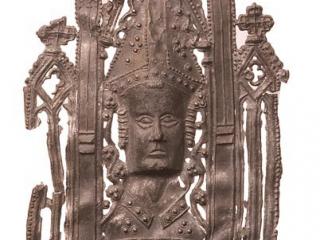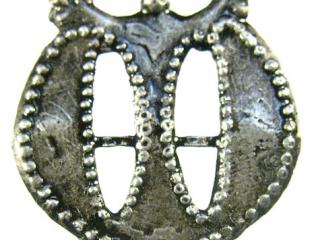Pilgrim badges
Pilgrim badges are decorations worn by some of those who undertake a Christian pilgrimage to a place considered holy by the Church. They became very popular in the later medieval period.
Typically made of lead alloy, they were sold as souvenirs at sites of Christian pilgrimage and bear imagery relating to the saint venerated there. The production of pilgrim badges flourished in the Middle Ages in Europe, particularly in the 14th and 15th centuries, but declined after the Protestant Reformation of the mid-16th century. Tens of thousands have been found since the mid-19th century, predominantly in rivers. Together they form the largest body of medieval art objects to survive today.
Pilgrimage sites housed a saint's relics: sometimes the whole body, sometimes a body part or significant object owned or touched by the saint. For example, St Thomas Becket was martyred at Canterbury Cathedral in England in 1170 and his body remained there, becoming the epicentre of an enormously popular cult. In 1220 the tomb was converted into a costly shrine. The pilgrim souvenirs associated with his cult have a particularly diverse array of imagery, including that of his shrine, his head reliquary and scenes from his life. Other major sites that produced badges were Santiago de Compostela, Cologne, Our Lady of Rocamadour and Jerusalem. Their badges bore images that were iconic and easily recognisable, such as the scallop shell, associated with pilgrimages along the Way of St James to the shrine of Saint James at Santiago de Compostela in modern Spain derived from shells collected by pilgrims on the beach, the Adoration of the Magi, and the St Peter or the Jerusalem Cross.
Shrines to the Virgin were common all over Christendom, in the England the most well known are Ipswich and Walsingham, as are badges associated with her. They often show her holding the Infant Christ, or represent the first letter of her name an M, St Thomas of Canterbury is often shown being martyred by one of a group of four knights and the relic of St John the Baptist's head, which was famously venerated at Amiens, is shown as a face on a plate.
Badges were made in the Middle Ages for purposes beyond pilgrim souvenirs; livery badges were presented to employees and allies by great figures, and became highly controversial in the decades leading to the Wars of the Roses. Some political badges have survived, including a fine one for the Black Prince. Other badges, with motifs such as lovers' tokens and mini brooches, were perhaps a form of cheap jewellery. Gazing at a collection of pilgrim souvenirs and medieval badges is to gain an insight into the visual world of medieval Christendom.
In England the tradition of making and wearing pilgrim badges died out in the early 16th century as pilgrimage initially declined in popularity and was then banned completely as the country became Anglican during the English Reformation.

